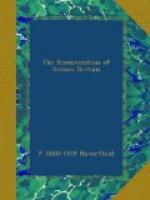[Footnote 1: C. iii. 1919=Dessau 2770. The inscription must be later than (about) A.D. 200, and it somewhat resembles another inscription (C. iii. 3228) of the reign of Gallienus, which mentions milites vexill. leg. Germanicar. et Britannicin. cum auxiliis earum. Presumably it is either earlier than the Gallic Empire of 258-73, or falls between that and the revolt of Carausius in 287. The notion of O. Fiebiger (De classium Italicarum historia, in Leipziger Studien, xv. 304) that it belongs to the Aremoric revolts of the fifth century is, I think, wrong. Such an expedition from Britain at such a date is incredible.]
[Footnote 2: The attempt to find eastern British names in Brittany seems a failure. M. de la Borderie, for instance, thinks that Corisopitum (or whatever the exact form of the name is) was colonized from Corstopitum (Corbridge on the Tyne, near Hadrian’s Wall). But the latter, always to some extent a military site, can hardly have sent out ordinary emigres, while the former has hardly an historical existence at all, and may be an ancient error for civitas Coriosolitum (C. xiii (I), i. p. 491).]
[Footnote 3: Freeman (Western Europe in the Fifth Century, p. 164) suggests that a migration of Britons into Gaul had been in progress, perhaps since the days of Magnus Maximus, and that by 470 there was a regular British state on the Loire, from which Riotamus led his 12,000 men. Hodgkin (Cornwall and Brittany, Penryn, 1911) suggests that the soldiers of Maximus settled on the Loire about 388, and that Riotamus was one of their descendants. He quotes Gildas as saying that the British troops of Maximus went abroad with him and never returned. That, however, is an entirely different thing from saying that they settled in a definite part of Gaul. For this latter statement I can find no evidence, and the Celtic revival in our island seems to provide a better setting for the whole incident of Riotamus.




